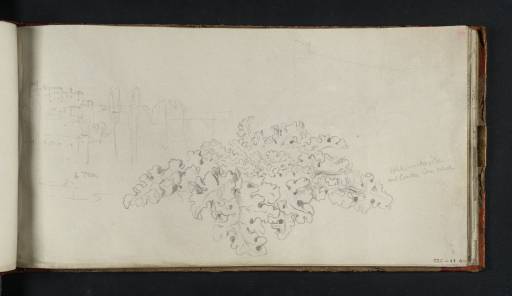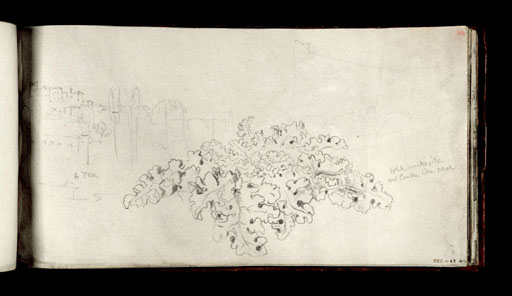Joseph Mallord William Turner Study of Acanthus Leaves, near the Arch of Constantine and the Colosseum, Rome 1819
Image 1 of 2
Joseph Mallord William Turner,
Study of Acanthus Leaves, near the Arch of Constantine and the Colosseum, Rome
1819
Joseph Mallord William Turner 1775–1851
Folio 37 Recto:
Study of Acanthus Leaves, near the Arch of Constantine and the Colosseum, Rome 1819
D16456
Turner Bequest CXC 42
Turner Bequest CXC 42
Pencil and grey watercolour wash on white wove paper, 130 x 255 mm
Inscribed by the artist in pencil ‘6 [?Trees]’ to left of leaves and ‘White [?undersides] | and Co[...] like velvet’ to right of leaves
Inscribed by ?John Ruskin with traces of red ink top right and by an unknown hand in pencil ‘42’ bottom right
Stamped in black ‘CXC 42’ bottom right
Inscribed by ?John Ruskin with traces of red ink top right and by an unknown hand in pencil ‘42’ bottom right
Stamped in black ‘CXC 42’ bottom right
Accepted by the nation as part of the Turner Bequest 1856
References
1909
A.J. Finberg, A Complete Inventory of the Drawings of the Turner Bequest, London 1909, vol.I, p.566, as ‘Study of leaves, with buildings in distance.’.
This page contains a study of acanthus leaves, a Mediterranean plant which is famously used as a stylised, decorative motif on Corinthian columns and other classical architectural features. The buildings visible in the background have been very faintly and summarily sketched but the suggestion of a triumphal arch in the centre as well as a large curved wall on the right-hand side, indicates that Turner was standing on the Via San Gregorio near the Arch of Constantine and the Colosseum, see folios 3 verso and 36 (D16398 and D16455; Turner Bequest CXC 4 and 41). The area of high ground on the left therefore represents the Palatine Hill. During the eighteenth and nineteenth centuries visitors to Rome often commented on the picturesque juxtaposition between the city’s ancient ruins and the plants which flourished around them, adding to the general sense of decline and decay. The Colosseum, in particular, was renowned for its abundant flora, including several rare species believed to be the only examples of their kind found in Europe. Several botanical studies were published during the nineteenth century, including Antonio Sebastiani’s, Flora Colisea, published in 1815, and this sketch may reflect Turner’s awareness of this contemporary interest.
Like many drawings within this sketchbook, the composition has been executed over a washed grey background. Although the subject represents an unusual focus for Turner during his 1819 tour of Italy, there are many other examples within his sketchbooks demonstrating a periodic interest in natural flora, see for example, the Egyptian Details sketchbook (Tate D03836; Turner Bequest LXVI 4) and the Devonshire Rivers No.3 and Wharfedale sketchbook (Tate D09870; Turner Bequest CXXXIV 69). Acanthus leaves can also be seen in the foreground of a drawing from the Rome: C. Studies sketchbook (see D16369; Turner Bequest CLXXXIX 42).
Verso:
Blank except for traces of grey watercolour
Blank except for traces of grey watercolour
Nicola Moorby
June 2009
How to cite
Nicola Moorby, ‘Study of Acanthus Leaves, near the Arch of Constantine and the Colosseum, Rome 1819 by Joseph Mallord William Turner’, catalogue entry, June 2009, in David Blayney Brown (ed.), J.M.W. Turner: Sketchbooks, Drawings and Watercolours, Tate Research Publication, December 2012, https://www


